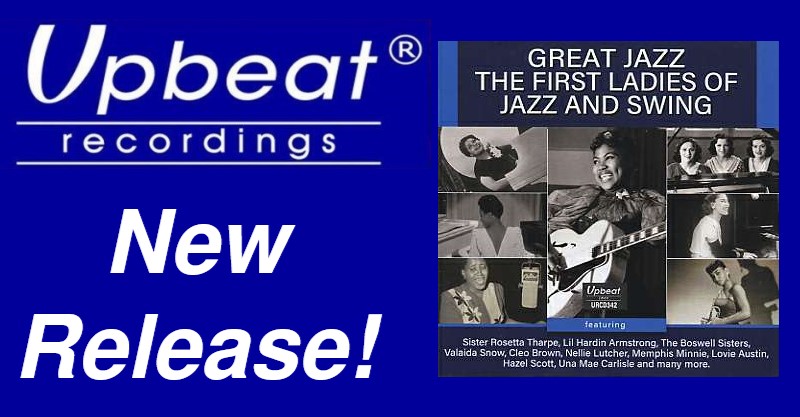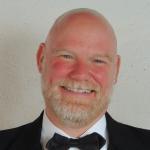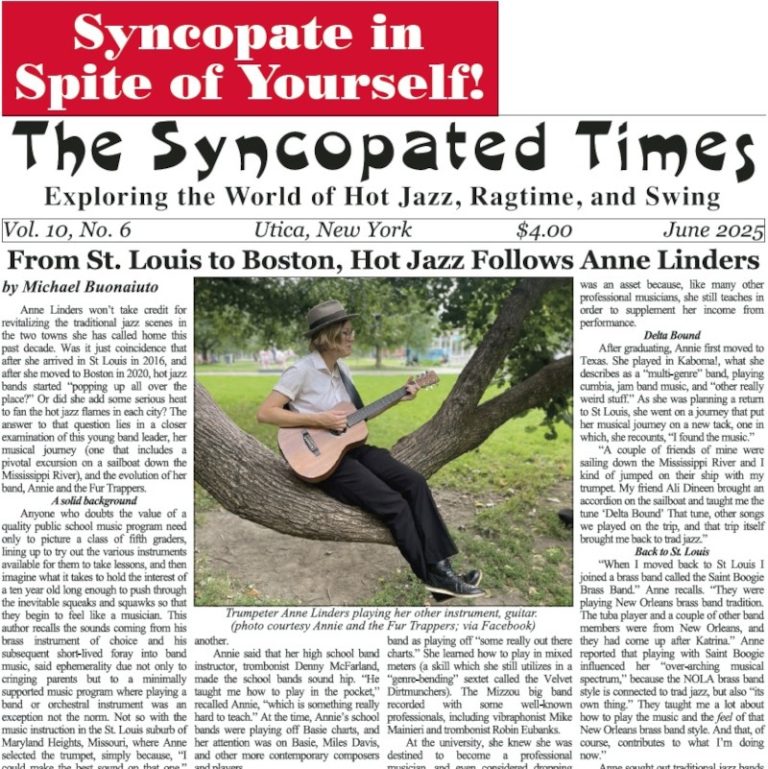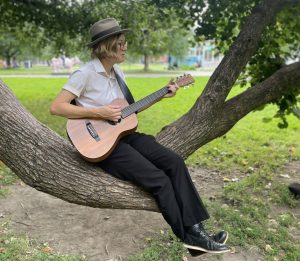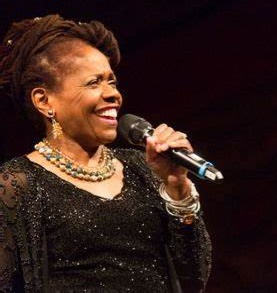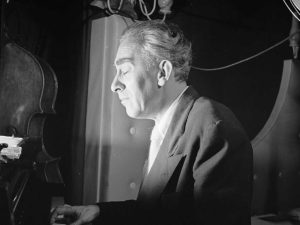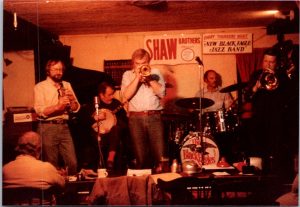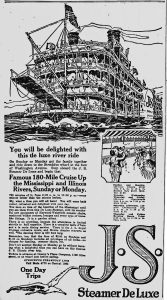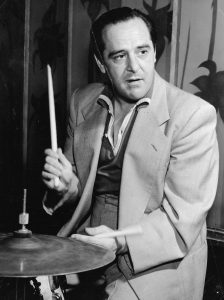Jeff Barnhart: Hal, last month we began exploring the music of the Dixieland Jug Blowers, concluding with the first side from their June 6, 1927, recording date at the Victor Recording Studio in Chicago. On this and subsequent dates, the band deviated greatly from the instrumentation featured on the dates in 1926. On the June dates we still hear violin (which makes sense since that’s what the leader, Clifford Hayes, played), but we’re down to one banjo from three, and now we hear trombone, two saxes, piano, and only one jug. One would think Hayes and Co. were going for a more urban (or perhaps merely commercial), less rustic sound, but listening to the first track we’ll cover this month, “Southern Shout,” that can’t be the whole story…this first side has as much of a hoe-down as a jazz feel. Can you get us started?
Hal Smith: In Ron Geesin’s liner notes for the “Louisville Stomp” CD on Frog, he mentions that “[Clifford Hayes’] aspirations were towards more sophisticated instrumental combinations…” I guess this particular grouping of instruments represented a kind of steppingstone between the more country sound of the band with multiple banjos and jugs and a jazzier approach. This lineup also de-emphasized the banjo too! Cal Smith played it on “National Blues,” which we discussed in the last installment, but played four-string guitar on most of the session.
It’s not surprising that you detect a “hoe-down” feel on “Southern Shout.” The first strain has the same chord changes as the Texas fiddle number “Beaumont Rag.” The ensemble plays the introduction and one chorus, followed with solos by violin, alto sax, guitar, soprano sax, trombone and another ensemble. The second strain is basically the same as “Salty Dog.” The ensemble plays twice, with an arranged break at the end of each chorus. There is another single-string guitar solo and one final ensemble chorus with an arranged ending. As mentioned before, the overall sound reminds me of the earliest recordings by Bob Wills and his Texas Playboys (minus the steel guitar and drums).
Take -2 was the one that was issued. For some reason, the Victor company designated the test record as “take 3.” If you compare them, I think the test actually hangs together a little better than the one that was commercially released.
Next up is a song that was named for a venue in New York City where Clifford Hayes, Cal Smith, and Earl McDonald had played in 1924. Later it was the title song of an album by Jim Kweskin’s Jug Band as well as the name of the jug band led by vocalist Maria Muldaur: “Garden of Joy.” Vocalist Elizabeth Washington is featured on this number. The ensemble plays an introduction, followed by a vocal verse and two vocal choruses. The ensemble plays a chorus, then there is one last vocal chorus with stoptimes. For me, the most interesting element of this performance is Earl McDonald’s four-beat jug playing!
The final selection recorded June 6 was—like all the songs on this session—composed by Clifford Hayes. “You’d Better Leave Me Alone, Sweet Papa” sounds to me like it could have been written several years earlier. The ensemble introduction includes bits and pieces of “When You and I Were Young, Maggie” and the last four bars of the verse to “Wabash Blues.” Elizabeth Washington sings the verse and chorus, then the band plays an instrumental chorus. The busy ensemble playing, with banjo once again in the rhythm section, makes the band sound quite a bit larger than it really was. And we get to hear a few more bars of that virtuoso four-beat jug playing! Jeff, what stands out on these sides for you?
JB: MacDonald doesn’t quite get the bass sonority on the jug that Henry Clifford was getting with the band in 1926, but I love his use of four-beat playing on some of these sides as well! Once we get to the second section of ’Southern Shout,” I was really impressed with two hot trombone breaks by Hense Grundy in the second half of the recording during the second strain. What a player! This one is bubbling over with joy and excitement, but I like the test recording that was not released much better! The differences include a more authoritative reed duo, a trombone solo and some alternate breaks including a funky one by pianist Dan Briscoe!
“Garden of Joy (Blues)” suffers from some out-of-tune jug playing in the intro. Ms. Washington is an undistinguished singer with a vibrato that reminds me of what someone trying to sing while driving down a bumpy road. After she sings, the ensemble is a joyous release, with no-one overplaying and that driving four-beat jug! Another ensemble would’ve been nice, but we end with a vocal…oh well. The most apt lyric from this song after hearing Ms. Washington sing it is “all I want is some more wine.”
I agree “You Better Leave Me Alone” sounds stylistically like a song from a few years prior to the recording. I hear the quotes you mention as well. I have a soft spot for tunes that feature surprising harmonic changes. Elizabeth Washington fares better on this tune with a faster tempo and fewer vocal long tones. Again, the ensemble chorus is the highlight!
There’s got to be a morning after
JB: We move to the following day for the next recording date, June 7, 1927, on which six tunes were recorded. The first three give Clifford Hayes compositional credit and involve the full ensemble that recorded the previous day.
The first tune is a medium-tempo stomp called “Only Mother Cares for Me.” The banjo is gone. After an ensemble 8-bar intro–the final measures of the chorus—and 4-bar vamp, Cal Smith plays a plaintive 17(!?!)-bar verse on 4-string guitar backed by Hayes’ violin: this section is marred by some harmonic confusion but Smith’s fingerpicking saves it! The first chorus reveals the melody as doubled by alto sax and violin; this shouldn’t work, but for me the tonal and octave differences between the two instruments make this somehow haunting. Then we’re treated to a duet with violin and hot muted trombone. Ms. Washington comes in with a vocal chorus, her strongest yet. Each chorus has a prominent Charleston beat starting the final eight bars. One wishes there had been time for one more hot ensemble following the vocal; instead the whole thing simply…stops…
A lovely, idiomatic 4-bar piano solo brings in “Love Blues,” and after part of the ensemble tries to play the next four bars rubato, the band settles into a bluesy tempo ready for Ms. Washington’s vocal entrance. On the blues chorus, there’s some great ensemble responses to her vocal phrases. Somehow, Cal Smith’s doubling Washington’s melody in places makes her vocal better. I sound like a broken record, but the ensemble sandwiched between the vocal choruses is tops with everyone playing hot and sweet.
“I Never Did Want You” prominently features guitar, violin on the verse, with McDonald playing some melody on the jug. A terrific interlude for piano, guitar and jug takes us into Clifford Hayes spoken-sung vocal. I found myself listening around his hokum to hear the beautifully played (and recorded) guitar accompaniment. The ensemble returns to play one more really hot chorus with a short ending.
And that’s just the first half of the date! Hal, what do hear on these sides, and can you take us through the rest of the session?
HS: There are some nice instrumental cameos on the remainder of the June 7 recording date, but the material and the vocals are pretty undistinguished. Elizabeth Washington sang the next two numbers that were recorded.
(Incidentally, she seems to have retired from singing not long after this session). “Only Mother Cares For Me” was written by—you guessed it—Clifford Hayes! The ensemble plays the last eight bars of the chorus as an introduction, with a fashionable Charleston rhythm thrown in. We hear from Cal Smith; a nice single-string guitar solo with good piano accompaniment by Johnny Gatewood, followed by alto, violin, trombone (and what sounds like some indecision regarding the chords) and a vocal chorus last. Once again, Cal Smith played some excellent accompaniment to the vocal.
“Love Blues,” after a well-played intro by Gatewood, loses tempo right away. The rest of the performance seems to plod along. The third take was the one issued; you have to wonder what made the previous two takes unacceptable to Victor! Elizabeth Washington sings a verse and four choruses with the full ensemble accompanying. There is an instrumental chorus, then one more vocal out—with some four-beat jug playing. This one certainly isn’t on the same level as the instrumentals which were recorded on the previous day!
Clifford Hayes himself sang (or, rather, spoke) “I Never Did Want You.” There isn’t much to recommend this side, beyond Cal Smith’s stellar guitar playing throughout, the collective ensembles behind the vocals and a little more four-beat jug by Earl McDonald.
The final two vocal sides from June 7 were recorded sans front line, featuring Prince La Vaughn. He is also credited as composer on both songs. The first, “If You Can’t Make It Easy, Get A Job And Go To Work” is based on the well-worn chord changes of songs like “I’m A Ding Dong Daddy,” “How Come You Do Me,” etc. At the end of the vocal chorus, pianist Gatewood sounds as though he is leading into a tag, but there is none. There is an instrumental chorus, then one more vocal with an arranged coda. The issued take (-2) has a very nice Eddie Lang-style guitar run by Cal Smith on the verse. Johnny Gatewood makes the same chordal mistake in the same spot at the end of the vocal. Earl McDonald sounds more prominent on the instrumental chorus and there is a bit of a misfire by the band on the coda which follows the final vocal.
Believe it or not, “When I Stopped Runnin’ I Was Home” is also based on “I’m A Ding Dong Daddy.” Besides a minor-key verse and some jug playing that sounds like Count Dracula’s laugh, this is a pretty uninspired minstrel show type of song. The fact that La Vaughn spoke, rather than sang, the lyrics takes even more air out of the tires. This side won’t make anyone forget Ben Harney! The Victor company may have felt as though further takes of the song would not be an improvement, since there is only one take.
Sometimes smaller is better
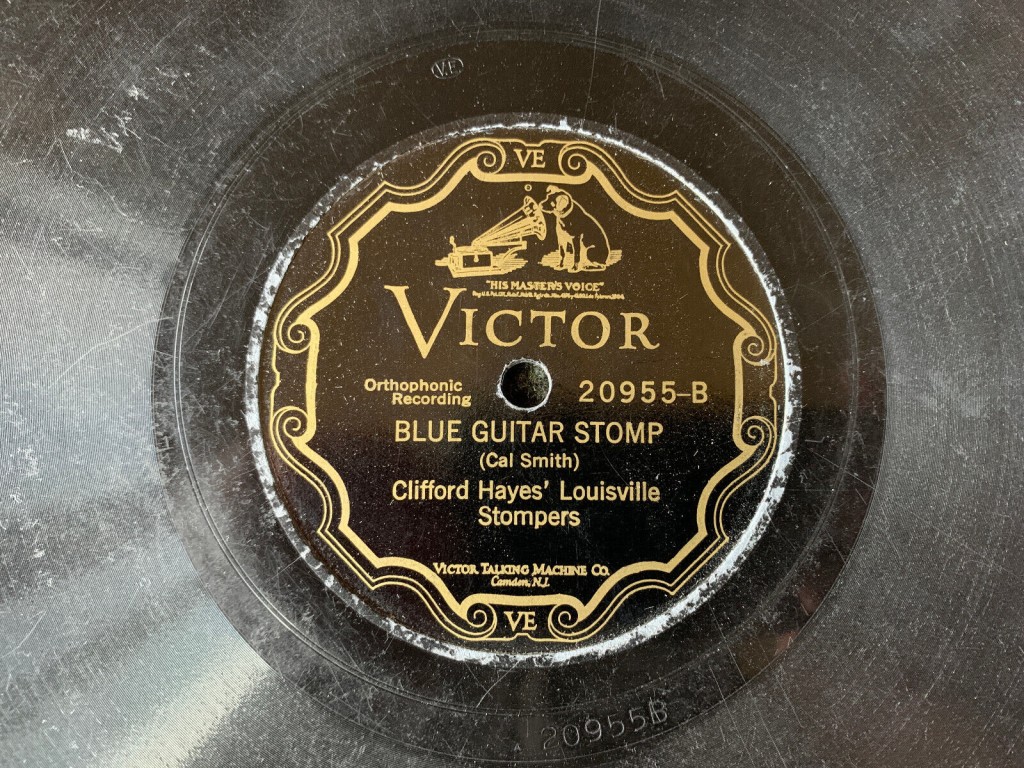 HS: I wonder if Hayes realized what a weak ending these vocals made to a session that had started out with so much promise. Maybe that is why Hense Grundy was added for one more instrumental: “Blue Guitar Stomp.” Written by Cal Smith, it is a feature for his expertly played tenor guitar and the first two choruses sound to me like Smith had been studying Eddie Lang. Dan Briscoe’s two lively piano choruses include some nice stride figures that could have come from Fats Waller. A minor-key interlude follows, with Grundy playing some freak effects on trombone with a mute. Clifford Hayes plays two country-sounding fiddle choruses, Smith returns for two more solos and the ensemble wraps things up, with everyone sounding energized. It must have been a relief for all of them to be able to cut loose after all those forgettable vocals! Do you agree, Jeff?
HS: I wonder if Hayes realized what a weak ending these vocals made to a session that had started out with so much promise. Maybe that is why Hense Grundy was added for one more instrumental: “Blue Guitar Stomp.” Written by Cal Smith, it is a feature for his expertly played tenor guitar and the first two choruses sound to me like Smith had been studying Eddie Lang. Dan Briscoe’s two lively piano choruses include some nice stride figures that could have come from Fats Waller. A minor-key interlude follows, with Grundy playing some freak effects on trombone with a mute. Clifford Hayes plays two country-sounding fiddle choruses, Smith returns for two more solos and the ensemble wraps things up, with everyone sounding energized. It must have been a relief for all of them to be able to cut loose after all those forgettable vocals! Do you agree, Jeff?
JB: Do I ever!! BTW, Your Count Dracula reference made me LOL—instead of “I Vant Blood” all I could hear in my head is “I Vant Moonshine!”
Clifford Hayes named the quartet that recorded the final tune you describe of the June 7 session “Clifford Hayes’ Louisville Stompers.” It was made up of musicians from the session. For me, it’s interesting who stayed and who didn’t: both reedsmen have disappeared, pianist Johnny Gatewood has been replaced by Dan Briscoe (they’d shared the June 6 date, but other than this final tune, Gatewood had done all the playing) AND…there’s NO jug!! A quartet of trombone, violin, piano and guitar created a side that bears repeated listening! The intro on “Blue Guitar Stomp” is cribbed from Jelly Roll Morton’s intro to “Shreveport Stomp” but surprises us as our ears think we’re heading to Bb (the intro is on an F7) but we stay in F! I love Cal Smith’s two blues choruses, Briscoe’s piano solo is solid, and Grundy’s two choruses in F minor are hot and sinister! It interests me that we don’t hear leader Hayes on his violin until more than halfway through the track. After his solo it’s back to the great work of Smith and one 12-bar ensemble out; it’s only on this last chorus that the quartet sounds thin…why take the jug away??
We skip ahead almost a year to May 31, 1928 for the next session. I’d love to know what gigs this quartet played in the almost year-long interim between sessions and where; this was a time when the real money (and fun) was made on the road, not in the studio. The quartet (with piano responsibilities split between Dan Briscoe and Johnny Gatewood) is the same as back in June 1927, but with Hayes playing alto sax on one track. “Tenor Guitar Stomp” starts with a quasi-classical introduction. Then Smith plays the first theme, remarkable for the length of bars (21) and the harmonic changes–we’re in F but spend a lot of time in Db (briefly the chord pattern is: F (3 bars); Db (2); Ab7 (7); C7 (1); F (3); Db (1); F (1); C7 (1); F (1); C7 (1) which repeats. Smith takes two choruses, Grundy plays some hot muted licks then Hayes enters with shaky intonation and seems unsure of when the chords change (even though he claimed composer credit). His one chorus is followed by Dan Briscoe who nervously speeds up a bit (this is his only side of the session and perhaps the odd length and harmonies made him quit).
“Bye-Bye Blues” (not the famous tune published in 1930 destined for virtuosic banjo-thwacking worldwide) for me is a far more successful side. Clifford Hayes has a lovely tone on alto and the first strain features him on melody with some nice backing from trombonist Grundy. A series of blues choruses features alto, tenor guitar, trombone (Grundy makes such good use of his various mutes during these tracks), violin (two choruses for our leader, with some virtuosity displayed on the second chorus) piano and a blues ensemble out with great three-way polyphony between guitar, trombone and violin. I enjoyed this one a lot!
Hal, I’d love to read your comments on these first sides and your thoughts on the remaining two for this date.
HS: “Tenor Guitar Stomp,” with that odd number of bars, could have been an early Western Swing number (or maybe not, with those odd-sounding bars of Db)! According to Ron Geeson’s liner notes to the “Frog Hop” CD of this material, after Dan Briscoe recorded the first side he “stormed out of the second session, vowing never to work with [Clifford] Hayes again.” So—Johnny Gatewood took over the piano chair for the remainder of the May 31 and June 1 sessions. As you said, there are some very good solos on “Tenor Guitar Stomp” and “Bye-Bye Blues.” It’s especially nice to hear Cal Smith prominently featured. He really made the most of his solo space!
“Tippin’ Through” is an oddly structured song, with an introduction that sounds like part of a verse. The repetition on bars 10-14 of the first strain summons up the image of a phonograph needle stuck on a crack. The piano solo makes me miss Dan Briscoe. I liked the way he used both ends of the keyboard, his awareness of novelty piano styles and his relentless afterbeats on the ensemble choruses. All those elements seem to have disappeared with Johnny Gatewood’s entrance.
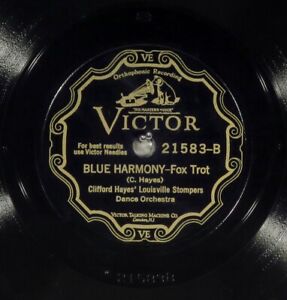 “Blue Harmony” begins with a phrase that recalls “Banjoreno” from two years earlier. Cal Smith and Hense Grundy play two choruses each before Clifford Hayes solos. What was he thinking on the first three bars?!? And this is the second take. You have to wonder what happened on the violin solo on take -1! Interestingly, the piano is only given one solo chorus where everyone else had two. Considering Gatewood’s tendency to speed up (and his emphasis on the middle register of the keyboard), it might have been a conscious decision to limit the number of piano choruses on these sides.
“Blue Harmony” begins with a phrase that recalls “Banjoreno” from two years earlier. Cal Smith and Hense Grundy play two choruses each before Clifford Hayes solos. What was he thinking on the first three bars?!? And this is the second take. You have to wonder what happened on the violin solo on take -1! Interestingly, the piano is only given one solo chorus where everyone else had two. Considering Gatewood’s tendency to speed up (and his emphasis on the middle register of the keyboard), it might have been a conscious decision to limit the number of piano choruses on these sides.
These recordings are pleasant enough, I guess, but this particular instrumental combination is a lot less interesting than the band with multiple banjos, jugs and reeds! Even a “tenor” jug on these 1928 sessions would have given the rhythm section a little boost. What do you think, Jeff? Do the Stompers sound like they are tired after the long road trip from Louisville to Chicago?
JB: They sure do, but who can blame them; although it’s only 300 between the two cities, this was the 1920’s so the trip wouldn’t have been easy. As traveling musicians, you and I both know that sometimes after long journeys energies are low. Combine that with the uninspired playing of Gatewood and you can see how enervating this session seemed to be. What they needed was a musical shot-in-the-arm, someone who could goad them to new heights, someone who could match and surpass the musical artistry and virtuosity of the vastly underrated Cal Smith!! And, after four more sides made by this same quartet on June 1, 1928 (which we’ll briefly cover in our final column on this group next month), that hoped-for juggernaut appears!! Hal, I’m going to leave it to you to choose whether to divulge the identity of this musical savior or make everyone wait until next month to learn who it is!
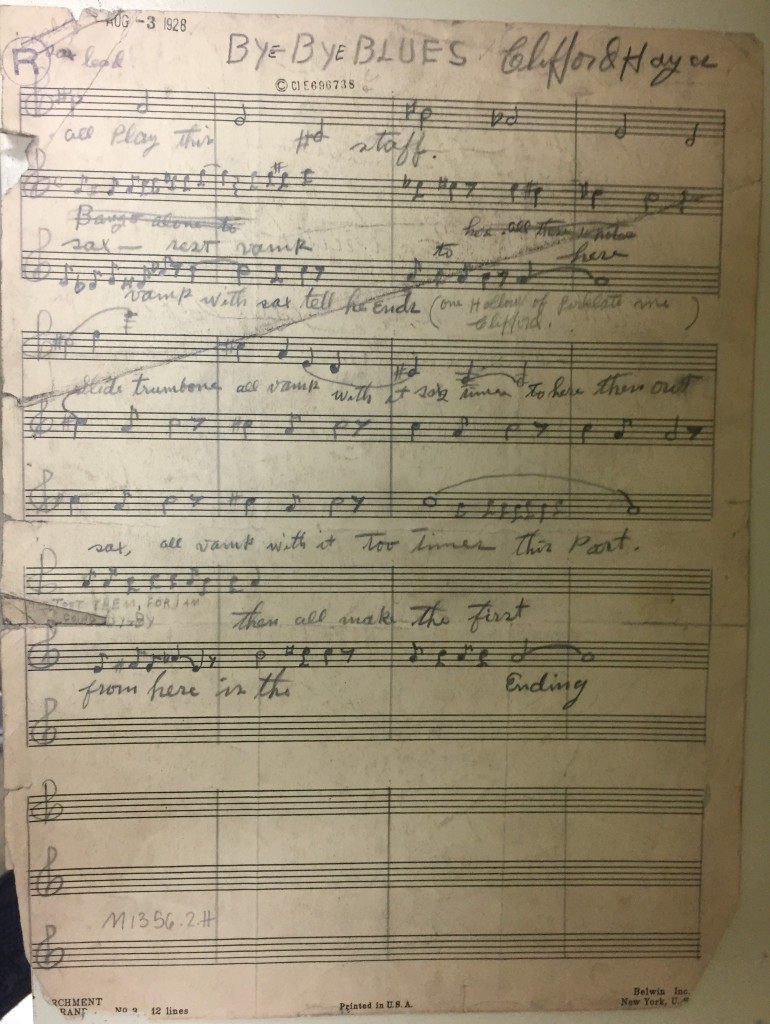
HS: I vote to wait on the “reveal.” Let’s just say that the “mystery musician” is going to take this band places that they never expected to go! Meanwhile, the Victor company thought highly enough of “Blue Guitar Stomp” to put it on the reverse of “Moten Stomp” by Bennie Moten’s Kansas City Orchestra. And “Blue Harmony” was the B side of McKinney’s Cotton Pickers’ record of “Four or Five Times.”
After a quick listen to a couple of the sides from the next day’s session (June 1, 1928), I think we will find a little more to talk about next time. June 1 will be “the calm before the storm,” so to speak. Jeff, have you previewed the recordings from June 1?
JB: Not yet, my friend. I see it’s the same line-up as the day before so I’d like to wait so the transformation that occurs in February 1929 is even more exhilarating! [N.B. The authors are fully aware this is no longer the 20th century, but if you dear readers won’t feel superannuated by showing some discipline and not “solving” the “mystery” with a few clicks of your overdeveloped thumbs, the surprise will be even more delicious!] Really looking forward to Part 3!!
Hal Smith is an Arkansas-based drummer and writer. He leads the El Dorado Jazz Band and the
Mortonia Seven and works with a variety of jazz and swing bands. Visit him online at
halsmithmusic.com
Jeff Barnhart is an internationally renowned pianist, vocalist, arranger, bandleader, recording artist, ASCAP composer, educator and entertainer. Visit him online atwww.jeffbarnhart.com. Email: Mysticrag@aol.com




